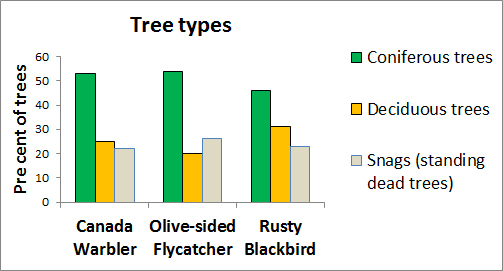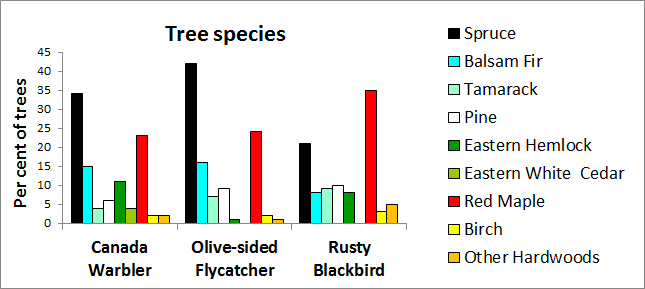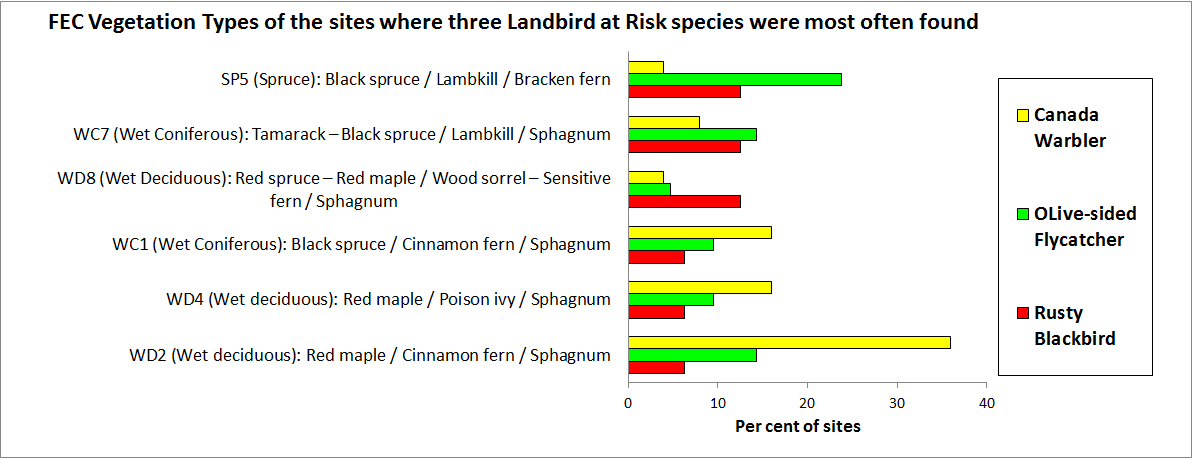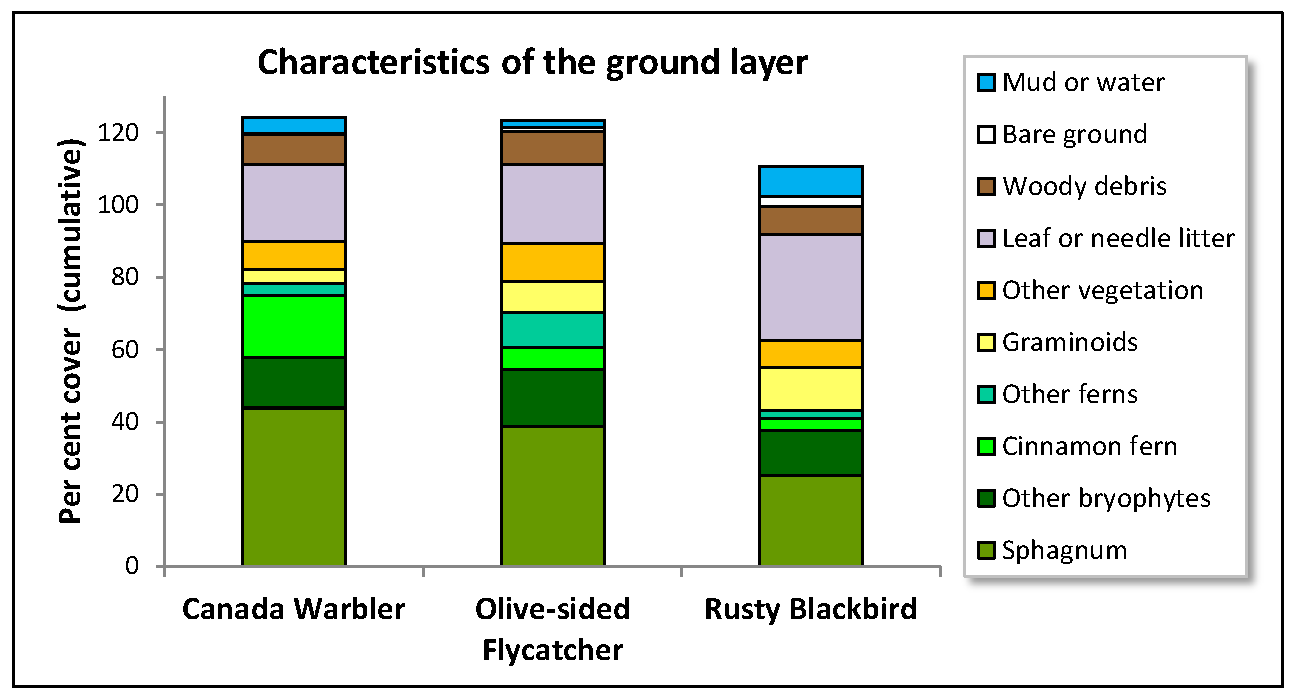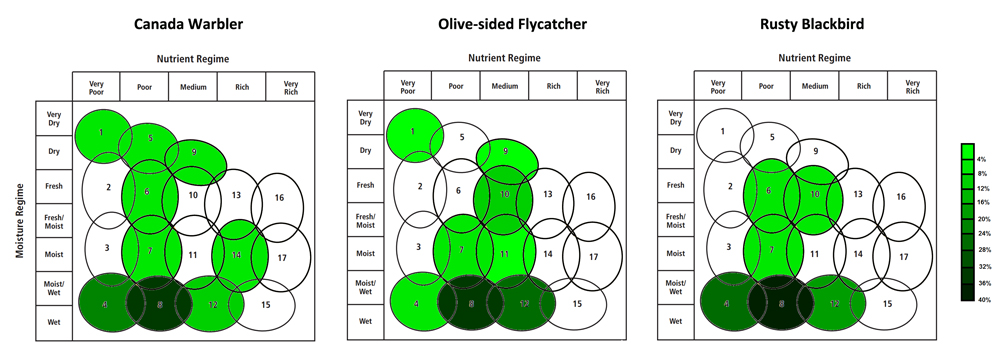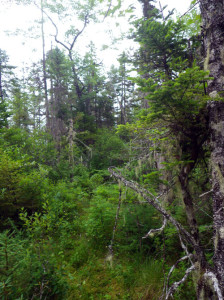 Our current project builds on previous work done by Dr. Cindy Staicer and her students (primarily Alana Westwood) to quantify habitat preferences of three SAR land birds (Canada Warbler, Olive-sided Flycatcher, and Rusty Blackbird) in Nova Scotia. In the summers of 2012-14, habitat surveys were conducted in southwest Nova Scotia at sites where these three species had previously been found. We used Nova Scotia Forest Ecosystem Classification (FEC) plots to classify the vegetation, soil type, and ecosite of each site, and transects to quantify the amount of leaf or needle cover of different habitat layers.
Our current project builds on previous work done by Dr. Cindy Staicer and her students (primarily Alana Westwood) to quantify habitat preferences of three SAR land birds (Canada Warbler, Olive-sided Flycatcher, and Rusty Blackbird) in Nova Scotia. In the summers of 2012-14, habitat surveys were conducted in southwest Nova Scotia at sites where these three species had previously been found. We used Nova Scotia Forest Ecosystem Classification (FEC) plots to classify the vegetation, soil type, and ecosite of each site, and transects to quantify the amount of leaf or needle cover of different habitat layers.
Our findings shed light on the specific features that make habitat suitable for each of these bird species, and highlight the common features of habitat used by all three species. By quantifying the specific features of the sites where these birds are found, we can determine the habitat preferences of these birds in Nova Scotia.
Results:
Trees
The Tree Types graph shows the percentage of coniferous trees, deciduous trees, or snags (standing dead trees of either type) found at sites with our three SAR land birds. Overall, coniferous trees dominated the sites where all three of the bird species were found, and deciduous trees and snags were each about half as numerous as coniferous trees.
The Tree Species graph shows these trees separated into species rather than type. The most abundant tree species was Spruce (mostly Black Spruce), which especially dominated Olive-sided Flycatcher sites. The second most abundant species was Red Maple, which especially dominated Rusty Blackbird sites. Balsam Fir and Pine (mostly White Pine) were common, and Eastern Hemlock was relatively common at Canada Warbler and Rusty Blackbird sites.
Vegetation Types
Sites were also classified by Vegetation Type according to FEC, which describe the forest based on tree species and types of ground vegetation in the understory.
All three bird species were predominantly found in six different Vegetation Types. Canada Warbler were most commonly found in Wet Deciduous forest with Red Maple, Cinnamon Fern, and Sphagnum moss, while Olive-sided Flycatcher favoured sites of open Spruce forest with a dense layer of Lambkill and Bracken Fern. Rusty Blackbirds were found across a variety of Vegetation Types, suggesting other factors are more important to their site selection than vegetation type.
For more information about FEC vegetation types, see http://novascotia.ca/natr/forestry/veg-types/introduction.asp
Vegetation Structure
Birds can also choose their habitat based on habitat structure rather than specific plant species. We quantified habitat structure by measuring the percentage of a site covered by plants in six different vegetation layers: canopy, coniferous saplings, deciduous samplings, high shrubs, low shrubs, ferns, and other ground vegetation.
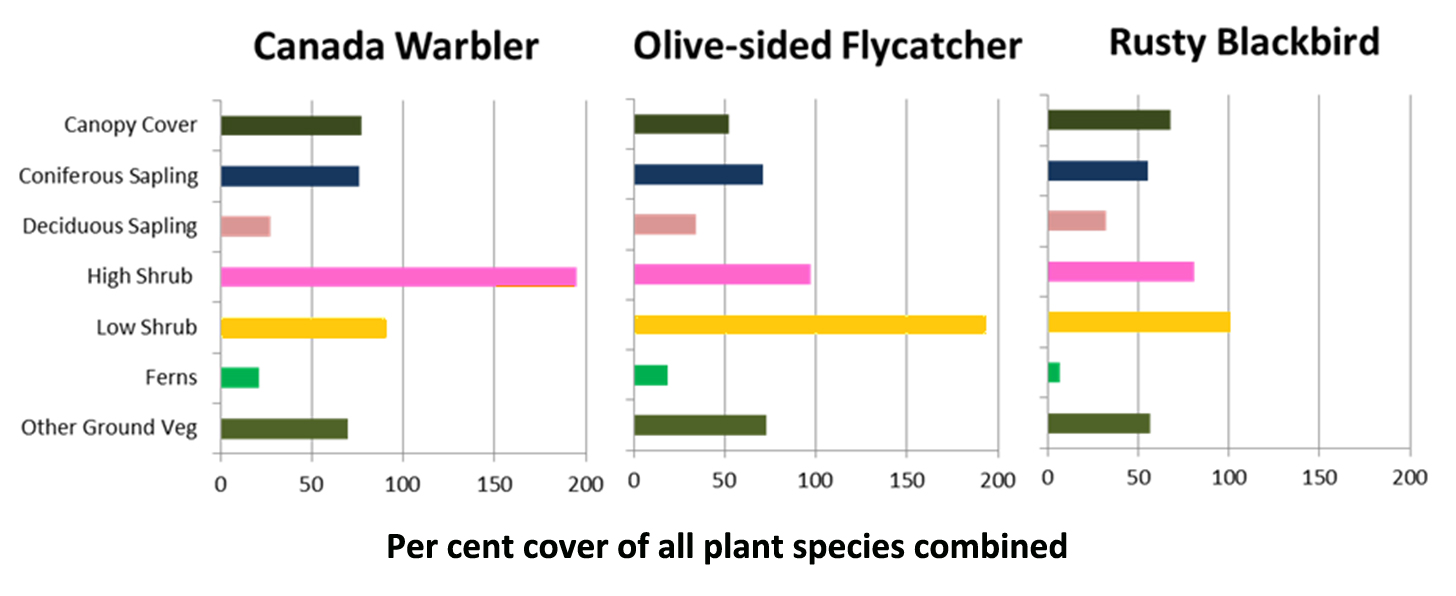
Vegetation Layers: Canopy Cover (overhead tree canopy); Coniferous Sapling (foliage of young conifers – e.g. black spruce, balsam fir, larch, pine, and hemlock); Deciduous Sapling (foliage of young deciduous trees – e.g. red maple and serviceberry); High Shrub (species that grow 2 m tall or higher – e.g. alder, Canada holly, false holly, and wild raisin); Low Shrub (species that usually grow to 1 m tall or less – e.g. lambkill, bayberry, leather leaf, and blueberry); Ferns (e.g. cinnamon and bracken); and Other Ground Vegetation (e.g. herbaceous plants, grasses, mosses, and liverworts).
The sites where Canada Warbler were found had a high percentage of high shrub cover. Olive-sided Flycatchers were found in sites with the lowest percentage of canopy cover (meaning they preferred open canopies) and high cover of the low shrub layer. In comparison to the other two species, the Rusty Blackbird had relatively less vegetation cover overall.
Ground Cover
A closer look at the ground revealed other habitat differences. Overall amounts of vegetation cover were similar for Canada Warbler and Olive-sided Flycatcher, but noticeably lower for Rusty Blackbird. Cinnamon Fern and Sphagnum Moss were most abundant at Canada Warbler sites, ferns and bryophytes were more abundant at Olive-sided Flycatcher sites, and Graminoids (grasses, sedges, and rushes) were most abundant at Rusty Blackbird sites. The amount of woody debris (tree twigs, branches, and trunks) on the ground was similar for all three species, though Rusty Blackbird sites had more leaf and needle litter, more bare ground, and more mud or water.
Soil Moisture and Nutrient Regimes
The grids above summarize the moisture and nutrient regimes of the habitat where each of the three bird species were found. Each oval represents a different moisture-nutrient regime, known as an ecosite. The darker the colour of an ecosite oval, the higher the number of sites within the parameters of that ecosite. For all three bird species the most common soil type was wet/poor (moisture/nutrient regime) where tree growth was limited by excessive moisture and low fertility. Typical habitat at these sites were coniferous or mixedwood treed swamps, with spruce, fir, and Red Maple.
For more information about ecosites and the vegetation types associated with different moisture and nutrient regimes, see www.gov.ns.ca/natr/library/forestry/reports/Ecosites.pdf

